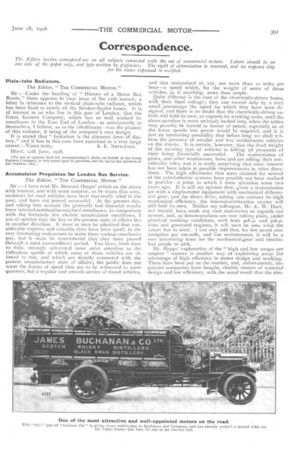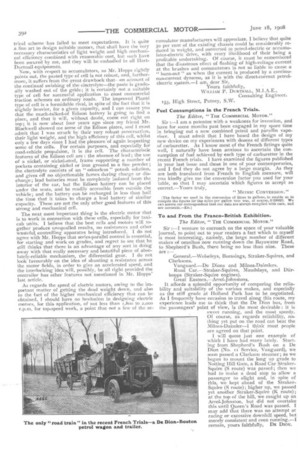Correspondence.
Page 17

Page 18

If you've noticed an error in this article please click here to report it so we can fix it.
The Editor invites correspond. nce on all subjects connected with the use of commercial motors. L el/err should be on one ride of the paper only, and ty pe-wr itten by preference. The right of abbreviation is reserved, and no responsi ility for the views expressed is accepted.
Plain-tube Radiators, The Editor, "THE COMMERCIAL MOTOR."
Sir :—Under the heading of " History of a Motor Bus Route," there appears in your issue of the iith instant, a letter in reference to the vertical plain-tube radiator, which has been fixed to nearly all the Straker-Squire buses. It is of interest to us who live in this part of London, that the Great Eastern Company, which has so well worked its omnibuses in the East End of London—as satisfactorily to themselves, I believe, as to the inhabitants--was the pioneer of this radiator, it being of the company's own design. It is stated that " Imitation is the sincerest form of flattery," and it has in this case been exercised to a very large extent.—Yours truly, S. E. NETTLETON. Ilford, 12th June, iqo8.
[We are of opinion that our correspondent's claim, on behalf of the Great Eastern Company, is very much open to question, but we invite the opinions of our rcaders.—End
Accumulator Propulsion for London Bus Service.
The Editor, "THE COMMERCIAL MOTOR."
Sir :—I have read Mr. Bernard Hopps' article on the above with interest, and with some surprise, as he states that accumulatorsfor road vehicles have been repeatedly tried in the past, and have not proved successful. At the present day, and taking into account the generally bad financial results from internal-c,ombustion-engined omnibuses, in comparison with the fortunate few electric accumulator omnibuses, I am of opinion that the key to the present state of affairs lies in another direction. It must at once be admitted that considerable expense and valuable time have been spent, in the very interesting endeavours to make these various omnibuses pay, but it must be remembered that they have passed through a most extraordinary period. You have, from time to time, strongly advocated more strict attention to the ridiculous speeds at which some of these vehicles are allowed to run, and which are directly connected with the present unsatisfactory state of affairs; the public does not want the bursts of speed that are to be witnessed in some quarters, but a regular and smooth service of timed vehicles,
and that maintained at, say, not more than 12 miles per hour—a speed which, for the weight of some of these vehicles, is, if anything, more than ample. Quite different is the case of the electrically-driven buses, with their fixed voltage; they can exceed only by a very small percentage the speed for which they have been designed, and there is no doubt that the electrically-driven vehicle will hold its own, as regards its working costs, until the above question is more seriously looked into, when the tables may possibly be turned in favour of petrol, especially as at the lower speeds less power would be required, and it is just an interesting possibility that before long we shall wit-• ness the presence of smaller and less cumbersome vehicles on the streets. It is certain, however, that the dead weight of the existing type of vehicles is killing all prospects of
their being financially successful. The maintenance cf gears, and other weaknesses, have and are telling their considerable tales, and it is really surprising that more interest has not been taken in possible improvements in other directions. The high efficiencies that were claimed for several of the petrol-electric systems have possibly not been realised in practice--a point to which I drew attention some two years ago. It is still my opinion that, given a transmission set with a single-motor equipment with mechanical differential gear, and the direct drive, taking into account its high mechanical efficiency, the internal-combustion engine will still hold its own. Neither my colleague, Mr. E. W. Hart, nor myself, have made any rash statements as regards our system, and, as demonstrations are now taking place, under practical working conditions, with both 4oh.p. and 3oh.p. sizes and governed engines, it will soon be seen what the future has in store. I can only add that, for low petrol consumption per ton-mile, and low maintenance, it will be a very 'interesting bone for the mechanical-gear and electricbus people to pick.
Mr. Hopps' explanation of the " high and low torque per ampere " motors is another way of explaining away the advantage of high efficiency in motor design and working. There have been put on the market, and, unfortunately, important companies have bought, electric motors of wasteful design and low efficiency, with the usual result that the elec trical scheme has failed to meet expectations. It is quite a fine art to design suitable motors, that shall have the very necessary characteristics of light weight and high mechanical efficiency combined with reasonable cost, but such have been secured by me, and they will be embodied in all HartDurtnall equipments.
Now, with respect to accumulators, as Mr. Hopps rightly points out, the pasted type of cell is not robust, and, furthermore, it suffers from the great drawback that—on account of the continual swishing of the electrolyte—the paste is gradually washed out of the grids; it is certainly not a suitable type of cell for successful application to most commercial traction schemes on ordinary roads. The improved Plante type of cell is a formidable rival, in spite of the fact that it is slightly heavier, for a given capacity, and I can assure you that the much-talked-of Edison battery is going to find a place, and that it will, without doubt, come out right on top; it is now about four years ago since my friend Mr. Blackwell showed me some of the Edison plates, and I must admit that I was struck by their very robust construction, their light weight, and the high efficiency of this cell, whilst only a few days since I had the pleasure of again inspecting some of the cells. For certain purposes, and especially for road-vehicle propulsion, it is the cell. The characteristic features of the Edison cell are : the absence of lead; the use of a nickel, or nickel-steel, frame supporting a number of pockets containing nickel or iron ground to a fine powder ; the electrolyte consists of an " odourless " potash solution, and gives off no objectionable fumes during charge or discharge; lead batteries must be completely isolated from the interior of the car, but the Edison battery can be placed under the seats, and be readily accessible from outside the vehicle; and the battery can be recharged in less than half the time that it takes to charge a lead battery of similar capacity. These are not the only other good features of this strong and mechanical cell.
The next most important thing is the electric motor that is to work in connection with these cells, especially for taxicab units. I believe that the best cells and motors will together produce unequalled results, no resistances and other wasteful, controlling apparatus being introduced. I do not agree with Mr, liopps that series-parallel control is essential, for starting and work on grades, and regret to see that he still thinks that there is an advantage of any sort in doing away with that really necessary and beautiful piece of absolutely-reliable mechanism, the differential gear. I do not look favourably on the idea of shunting a resistance across the motor fields, in order to give an accelerated speed, and the interlocking idea will, possibly, be all right provided the controller has other features not mentioned in Mr. Hopps' last article.
As regards the speed of electric motors, owing to the important matter of getting the dead weight down, and also
to the fact of the higher mechanical efficiency that cart be obtained, I should have no hesitation in designing electric motors, for this application, of not less than 1,800 to 2,000 r.p.tn. for top-speed work, a point that not a few of the ac curnulator manufacturers will appreciate. I believe that quite 5o per cent of the existing chassis could be considerably reduced in weight, and converted to petrol-electric or accumulator-electric drive, with every likelihood of their being a
profitable undertaking. Of course, it must be remembered that the disastrous effect of flashing of high-voltage current at the brushes and commutators is not so liable to cause a " burn-out " as when the current is produced by a continuous-current dynamo, as it is with the direct-current petrolelectric s3Istem.—I am, dear Sir, Yours faithfully, WILLIA:kr P. DURTNALL, Consulting Engineer.
153, High Street, Putney, S.W.
Fuel Consumptions in the French Trials.
The Editor, "THE COMMERCIAL MOTOR."
Sir :—I am a patentee with a weakness for invention, and have for some months past been engaged in my spare time in bringing out a new combined petrol and paraffin vaporiser. I must admit that I have based the design of my new device on my experiences with dozens of different types of carburetter. As I know most of the French fittings quite well, I naturally have been anxious to ascertain the consumption of fuel achieved by each type of carburetter in the recent French trials. I have examined the figures published in your last issue and those in one of your contemporaries, and I find they do not agree by a large margin. As they are both translated from French to English measure, will you kindly give me the conversion factor you used for your table, so that I may ascertain which figures to accept as correct.—Yours truly,
"METRIC CONVERSION."
[The factor we used in the conversion of litres to gallons, to enable us to compile the figures for the miles per gallon rate was, of course, 0.221/097. We can assure our correspondent that our data are always compiled with care, arid are accurate.—Er,.} To and From the Franco-British Exhibition.
The Editor, "THE COMMERCIAL MOTOR."
Sir :—I venture to encroach on the space of your valuable journal, to point out to your readers a fact which to myself is most interesting, namely, the large number of different makes of omnibus now running down the Bayswater Road, to Shepherd's Bush, there being no less than nine. These are :—
General.—Wolseleys, Buessing-s, Straker-Squires, and Clarksons.
Vanguard.--De Dions and Milnes-Daimlers.
Road Car.—Straker-Squires, Maudslays, and DLit.kopps (Straker-Squire engines).
Great Eastern.—Arrol-Johnstons.
It affords a splendid opportunity of comparing the reliability and suitability of the various makes, and especially as the stiff grade at Holland Park has to be negotiated. As I frequently have occasion to travel along this route, my experience leads me to think that the De Dion bus, from the passengers' point of view, is the most desirable : it is sweet running, and the most speedy. Of course, as regards reliability, nothing yet put on the road can beat the Milnes-Daimler—I think most people are agreed on that point.
I will quote just one example of which I have had many lately. Starting from Shepherd's Bush on a De Dion (No. II Service, Vanguard), we soon passed a Clarkson steamer ; as we began to mount the long up grade to Notting Hill Gate, a Road Car StrakerSquire (S route) was passed; then we had to make a dead stop to allow a passenger to alight and, in spite of this, we kept ahead of the StrakerSquire (S route); higher up, we passed yet another Straker-Squire (K route); at the top of the hill, we caught up an Arrol-Johnston, but did not overtake this until Queen's Road was passed. I may add that there was no attempt at racing or excessive downhill speed, but merely consistent and even running.—I remain, yours faithfully, Ds DION.






















